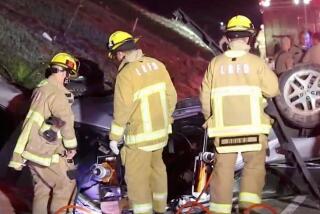Simi Freeway to Get Interim Safety Barrier
- Share via
Prompted by a fiery, cross-median crash that killed three people last month, state transportation officials Tuesday ordered a temporary barrier installed between the eastbound and westbound lanes of the Simi Valley Freeway.
The $700,000 barrier will be in place by the end of the year along a five-mile stretch between Balboa Boulevard and De Soto Avenue, said Larry Loudon, a state Department of Transportation district traffic engineer.
The Jan. 31 crash, which also injured four motorists, began when a big-rig truck collided with a Toyota Celica in the westbound lanes, sending the car careening across the 54-foot-wide dirt median into oncoming traffic.
A permanent barrier is scheduled for construction in 1994 as part of a $39.4-million project to widen the freeway and add car-pool lanes, Loudon said. The permanent concrete barrier has been delayed for two years because of state funding problems, he said.
But he said the fatal, five-car crash forced state transportation officials to consider installing a temporary barrier until the permanent barrier is erected.
“I guess the accident heightened our interest in a barrier,” he said, adding that state transportation officials estimate that about 20 cross-median accidents could occur in the two-year period until the permanent barrier is installed.
California Highway Patrol investigators, meanwhile, continue to investigate the cause of the collision and to see if charges should be filed against the driver of the truck, a CHP spokeswoman said.
The lack of a barrier along the stretch of the Simi Valley Freeway has concerned several public officials, including state Sen. Ed Davis (R-Santa Clarita), who has offered to lobby the California Transportation Commission to pay for the barrier.
On Monday, a spokesman for Davis said the senator is happy that state officials have decided to install the temporary barrier. “As far as the median is concerned, it’s good news for the thousands of people that use the 118 Freeway everyday,” said Davis’ administrative assistant, Hunt Braly. “It will be a safer road from now on.”
Between June, 1986, and June, 1989, Caltrans officials reported 28 cross-median accidents, including four fatalities on an 18.5-mile stretch of the freeway that included the site of the five-car crash, according to information received by Davis’ office.
Loudon said there have been eight to 10 cross-median accidents on that freeway stretch each year since 1989, but none were fatal until the most recent crash.
The movable concrete barriers will be installed along the inside shoulder of one side of the freeway, Loudon said. He said state transportation officials have not decided whether the barriers will run along the eastbound or westbound lanes.
The temporary barrier originally was expected to cost $1 million to $1.5 million because state officials assumed the barrier would be needed on a longer stretch, Loudon said. He said they later realized that the barrier would only be needed on five miles of the freeway.
Loudon said officials have not decided how they will pay for the temporary barrier.
“It’s going to take some creative financing to get it, but we think we can get it,” he said.
More to Read
Sign up for Essential California
The most important California stories and recommendations in your inbox every morning.
You may occasionally receive promotional content from the Los Angeles Times.











